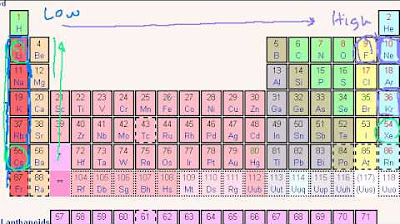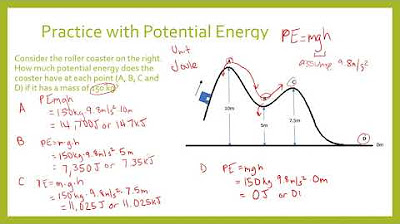Lecture 9 - Some relations from the Bohr's theory
TLDRThis script delves into the Bohr model of the atom, explaining the concept of total energy for an electron as the sum of kinetic and potential energy. It discusses the derivation of the electron's total energy formula, the relationship between the electron's velocity and its orbital radius, and how these relate to Planck's constant. The script also covers important atomic energy states, including the ground state, excited states, ionization energy, and excitation energy, providing foundational knowledge for understanding atomic structure and energy transitions.
Takeaways
- 🔬 The total energy of an electron is the sum of its kinetic and potential energy, which is a key concept in understanding atomic structure.
- 📚 Potential energy is calculated as the integral of the Coulombic force over distance, which is a fundamental concept in physics.
- 🧲 The equation for the total energy of an electron is derived to be proportional to -\(\frac{kZe^2}{2r}\), where \(k\) is Coulomb's constant, \(Z\) is the atomic number, \(e\) is the elementary charge, and \(r\) is the radius of the electron's orbit.
- 🔍 The relationship between the electron's momentum and the radius of its orbit is given by \(Mv^2r = k\frac{Ze^2}{r^2}\), highlighting the balance between centrifugal and electrostatic forces.
- 🔄 By substituting the value of \(r\) from the Bohr model, the energy equation is simplified to a form involving constants and variables, leading to an expression in electron volts.
- 🌐 The energy of an electron varies with the shell it occupies, indicated by the quantum number \(n\), and is directly related to the atomic number \(Z\).
- ⚡ The velocity of an electron in its orbit is derived from the Bohr model and is proportional to \(\frac{Z}{n}\), with a constant factor related to fundamental physical constants.
- 🌀 The circumference of an electron's orbit is related to Planck's constant, suggesting a connection between quantum mechanics and the classical orbit of electrons.
- 🏁 The ground state of an atom is defined as the lowest energy state with the electron in the innermost shell, while excited states are higher energy states with electrons in outer shells.
- ⚡️ Ionization energy is the energy required to free an electron from an atom, which is calculated as the difference between the energy at infinity and the ground state energy.
- 🔄 Excitation energy is the energy needed for an electron to transition from one energy level to another, and is a key concept in understanding atomic transitions and spectra.
Q & A
What is the total energy of an electron according to the script?
-The total energy of an electron is the sum of its kinetic and potential energy. It is described by the equation: Total Energy = (1/2) * MV^2 - (-k * Z * e^2) / R.
What is the relationship between the kinetic energy and potential energy of an electron?
-The potential energy is twice the total energy, as the total energy is the sum of kinetic and potential energy and they are opposite in sign.
How is the potential energy defined in the context of the script?
-Potential energy is defined as the integral of the Coulombic force dot dr, which is the work done by the force as the electron moves through a distance dr.
What is the formula for the velocity of an electron in the context of Bohr's model?
-The velocity of an electron is given by the formula: V = (2 * π * k * Z * e^2) / (n * h), where k is the Coulomb's constant, Z is the atomic number, e is the charge of the electron, n is the shell number, and h is Planck's constant.
What is the significance of the equation MV^2/R = k * Z * e^2 / R^2 in the script?
-This equation represents the balance between the centrifugal force (MV^2/R) and the electrostatic force (k * Z * e^2 / R^2) in Bohr's model of the atom.
What is the formula for the energy of an electron in terms of the atomic number Z and the shell number n?
-The energy of an electron is given by the formula: Energy = -13.6 * Z^2 / n^2 electron volts, where Z is the atomic number and n is the shell number.
What is the ground state in Bohr's model of the atom?
-The ground state is the lowest energy state of an atom or ion, where the electron is in the orbit closest to the nucleus (n=1).
What is the definition of ionization energy according to the script?
-Ionization energy is the energy required to free an electron from an atom, which is the difference between the final energy (when the electron is free) and the initial energy when the electron is bound to the atom.
What is the relationship between the circumference of an electron's orbit and Planck's constant?
-The circumference of an electron's orbit is related to Planck's constant by the formula: Circumference = (2 * π * R) = n * h / (M * V), where h is Planck's constant, M is the mass of the electron, and V is its velocity.
What is the excitation energy in the context of Bohr's model?
-Excitation energy is the energy required for an electron to jump from one orbit to another, moving to a higher energy state.
How is the binding energy related to ionization energy in the script?
-Binding energy, or separation energy, is defined as the ionization energy, which is the energy that must be given to an atom to free its electrons.
Outlines
🔬 Electron Energy and Bohr's Model
This paragraph introduces the concept of an electron's total energy, which is the sum of its kinetic and potential energies. The potential energy is calculated as the integral of the Coulombic force, a topic to be covered later in physics. The total energy is expressed by an equation involving variables like mass (M), velocity (V), and distance (R), with constants such as the electrostatic force constant (k) and the charge of the electron (e). The relationship between the centrifugal and electrostatic forces is used to derive an expression for the electron's energy in terms of the atomic number (Z) and the shell number (n). The energy is found to be negative, indicating that electrons are bound within the atom, and the formula is simplified to show the energy in electron volts per atom.
🌐 Bohr's Model: Orbital Relations and Energy States
The second paragraph delves into the Bohr model of the atom, focusing on the relationship between the circumference of an electron's orbit and Planck's constant. It explains how the circumference of an orbit can be related to the de Broglie wavelength (λ), which is a key concept in quantum mechanics. The paragraph also defines terms such as ground state, excited states, ionization energy, and excitation energy within the context of the Bohr model. The ground state is identified as the lowest energy state with the electron in the innermost shell (n=1), while excited states are higher energy states with electrons in outer shells. Ionization energy is the energy required to free an electron from the atom, which is found by evaluating the energy formula as n approaches infinity. Excitation energy is the energy needed for an electron to transition between orbits.
🔋 Binding Energy and Ionization Energy
The final paragraph discusses the concept of binding energy, which is synonymous with ionization energy—the energy required to remove an electron from an atom and make it free. It emphasizes that as the electron is freed, the energy of the system approaches zero, indicating that the ionization energy is the difference between the initial bound state energy and the final free state energy. The paragraph reinforces the idea that the ionization energy is a critical parameter in understanding the stability and reactivity of atoms and ions.
Mindmap
Keywords
💡Total Energy
💡Kinetic Energy
💡Potential Energy
💡Coulombic Force
💡Bohr Model
💡Electrostatic Force
💡Centrifugal Force
💡Ionization Energy
💡Excitation Energy
💡Binding Energy
💡Ground State
💡Excited State
💡Velocity of Electron
💡Planck's Constant
Highlights
The total energy of an electron is the sum of kinetic and potential energy.
Potential energy is calculated as the integral of the Coulombic force.
The formula for total energy is derived as kinetic energy minus potential energy.
The relationship between MV^2/r and the electrostatic force is established.
The expression for energy simplifies to a function of atomic number Z and shell number n.
The velocity of an electron is related to the Bohr model and Planck's constant.
The circumference of an electron's orbit is related to Planck's constant.
The ground state of an atom is defined as the lowest energy state.
Excited states are states other than the ground state with electrons in higher energy levels.
Ionization energy is the energy required to free an electron from an atom.
Excitation energy is the energy needed for an electron to jump between orbits.
Binding energy is the energy required to separate an electron from an atom, synonymous with ionization energy.
The formula for total energy includes constants and variables separated for clarity.
The negative sign in the energy equation indicates the stability of electrons in an atom.
The Bohr model provides a framework for understanding electron orbits and energy levels.
The relationship between electron velocity and atomic properties is quantified.
The concept of shell numbers and their relation to energy levels is explained.
Transcripts
Browse More Related Video

Bohr Model of the Hydrogen Atom, Electron Transitions, Atomic Energy Levels, Lyman & Balmer Series

Bohr's Atomic Model

How Much Energy is Required to Change the Orbit of a Satellite?

Ionization Energy - Basic Introduction

Periodic Table Trends: Ionization Energy

Potential and Kinetic Energy with Practice Problems
5.0 / 5 (0 votes)
Thanks for rating: